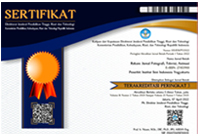Hal-Hal yang Absen dalam Pencatatan Mengenai Film Nasional
Abstract
ABSTRAK
Penulisan narasi besar mengenai Film Nasional lebih sering dilakukan daripada penulisan narasi kecil mengenai film-film di Indonesia. Seperti halnya dilakukan oleh para penulis buku berjudul Merayakan Film Nasional (yang ditulis oleh Adrian Jonathan Pasaribu, Hikmat Darmawan, dan Totot Indrarto). Tujuan yang dilakukan tentunya tidak lagi melihat Film Nasional sebatas teritorial saja, melainkan mendorong pembaca dan pembuat film untuk melepas beban-beban makna Nasional. Hingga mulai merepresentasikan bentuk-bentuk film Pascanasional melalui aspek fungsional dan relasional-nya. Tetapi, jika hanya bergantung pada narasi besar saja, upaya pemaknaan tersebut justru melanggengkan praktik imaji orientalis Barat pada film-film di Indonesia.
Oleh karena itu, penulis hendak melengkapi narasi kecil yang tidak muncul pada buku Merayakan Film Nasional. Penulisan narasi kecil tersebut, dilakukan melalui tiga model analisis: 1) proses re-intepretasi mitos pada masyarakat kontemporer dalam film di Indonesia, 2) model re-intepretasi realitas sebagai sebuah aksi protes dan komikal dalam film di Indonesia, dan 3) unsur-unsur yang mendorong terjadinya hibrida teks pada film terkini, sebagai upaya mengubah wajah film di Indonesia yang lebih beragam.
ABSTRACT
The writings on national Film historical in Indonesia has been going more often than the ones discussing those works on the periphery. The book titled Merayakan Film Nasional, written by Adrian Jonathan Pasaribu, Hikmat Darmawan, and Totot Indrarto, remains to focus on the first category. Instead of aim to look at Indonesia National Film based on the territory, the book encourages the readers and Indonesian filmmakers to disengage from the burden of “National”. Additonally, the book also attempts to represent the Post-Colonial Films thorugh its function and relations aspects. Nevertheless, it is problematic when the access for National Film references only open for the big ones since its limits the interpretation and perpetuates the practice of orientalism perspective on Indonesian films.
In This case, I will try to complete the periphery side which didn’t exist on Merayakan Film Nasional. There are 3 methods to analyzing National Film into the periphery aspects: 1) Re-intepretation the myth of contemporary society which framed on Indonesia Film. 2) The reality-model as the based to combining between protest and comical form in Indonesian film. 3) The elements that make hybrid-text happen in contemporary film, as the way to changes the image of Indonesian film.
Keywords
Full Text:
PDFReferences
Ajidarma, S. G. (2014). Film Indonesia dan Identitas Nasional dalam Kondisi Pascanasional. Retrieved from https://vimeo.com/90500526
Akbar, G. (2018). Anggarbini. Indonesia.
Anderson, J. L., & Richie, D. (1959). The Japanese Film: Art and Industry. Michigan: The University of Michigan.
Audiard, J. (2015). Dheepan. Prancis.
Beauvior, S. de. (2003). Second Sex: Fakta dan Mitos. Surabaya: Pustaka Promethea.
Bhanuteja, W. (2016). Prenjak (In The Year of Monkey). Indonesia.
de Bary, B., & Burch, N. (1982). To the Distant Observer: Form and Meaning in the Japanese Cinema. Journal of Japanese Studies. https://doi.org/10.2307/132349
Elsaesser, T. (2013). ImperSonations: National Cinema, Historical Imaginaries, and New Cinema Europe. Mise Au Point, 5. Retrieved from https://journals.openedition.org/map/1480
Forrest, T. (2015). Realism as Protest: Kluge, Schlingensief, Haneke. Bielefeld: Transcript Verlag.
Frey, M. (2016). Extreme cinema: The transgressive rhetoric of today’s art film culture. In Extreme Cinema: The Transgressive Rhetoric of Today’S Art Film Culture.
Heeren van, K. (2012). Contemporary Indonesian Film; Spirits of Reform and ghosts from the past. Contemporary Indonesian Film; Spirits of Reform and Ghosts from the
DOI: https://doi.org/10.24821/rekam.v15i2.2046
Refbacks
- There are currently no refbacks.

This work is licensed under a Creative Commons Attribution 4.0 International License.



